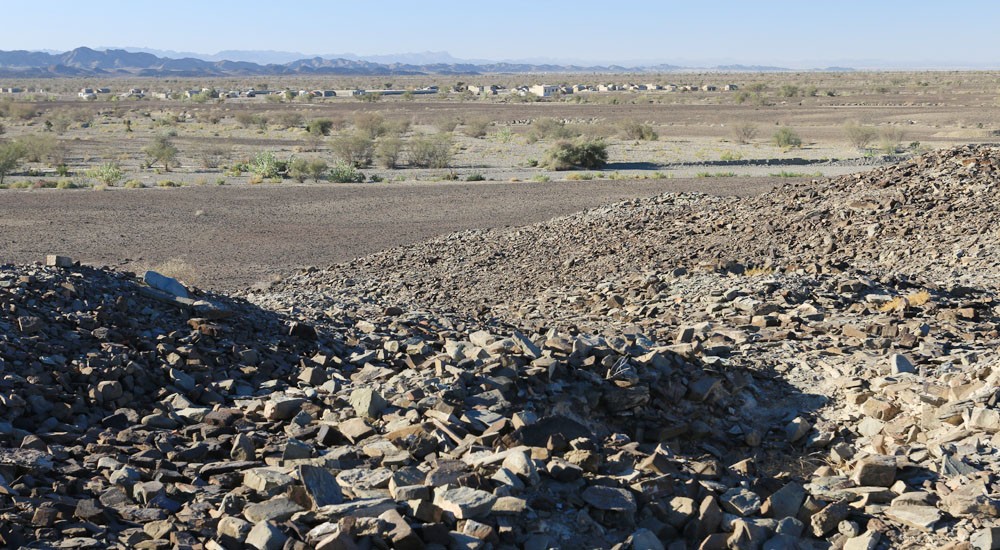
Travelling on a timeless highroad, searching for a milestone from an old map near the village of Malar

Semiramis, the legendary queen of Mesopotamia, is said to have invaded India late in the 9th century BCE. After the adventure, she left the country by way of Makran in whose waterless and desolate wastes she lost her entire force, save 20 men. Three hundred years later, Cyrus the Great, the Achaemenian king of Persia, duplicated the same feat. He was even less fortunate being able to lead away just seven of his great army to safety.
In 325 BCE, Alexander’s choice of exit from India was guided by word of the disastrous marches of these two earlier monarchs. Hoping to go one better on these illustrious predecessors, Alexander resolved to reach Persia by land through Makran. Though he lost some 20,000 souls, and considerable treasure, either to the intense autumn heat of the parched land or to the fury of a flash flood in one of the rivers, he and his army did make it to safety more or less intact.
Unread people relying on fanciful hearsay believe the route Alexander followed was by the seaboard. Anyone who knows the topography of the coast would recognise that this could never be a favourable route for a large force. But a close study of the sources show us that leaving Lasbela, he went by Jhao Pass to Awaran and on to Turbat, now once again known by its ancient name of Kech.
Surely his two predecessors would also have taken the same way. As much as local hearsay historians may want to believe otherwise, it was this same way, fully a thousand years after Alexander, that Mohammad bin Qasim brought his army down to Sindh.
A reading of Arab historians of the 9th century and later shows that Kech, a rich emporium of trade, was a busy staging point on a much-frequented east-west highroad between the Indus Valley and Mesopotamia. Modern archaeologists taking us eight millenniums into the past show that even at that early date much traffic passed between these two famous centres of civilisation of the ancient world.
In our times, this was the way traffic between Karachi and Gwadar went through Lasbela, Awaran, Kech and Pasni. The normal bus journey between the two terminuses, a bone-jarring and dreary affair, took up nearly two days leaving the traveller unfit for anything but a long rest. But along the alignment from Lasbela to Kech, the road was a classic caravan route with way stations and eateries and plenty of that romantic thrill of the rough travel of days gone by.
Pausing on the way generally meant running into a dusty, ageless innkeeper who spun yarns of ancient glory both Baloch and non-Baloch. There were tales of the time some malevolent gods set the hills on fire turning them black or of the large millstone whose central hole permitted only a person born out of wedlock to pass through, no matter how obese. Supposedly dating back to the age of prophets, the stone was even now a sure way of confirming biological legitimacy. This was the kind of highroad on which travel writers could write entire books.
But then Makran Coastal Highway, a high-speed conduit cutting the distance between Karachi and Gwadar to less than eight hours, was built. For the first time in 8,000 years and more, the old highroad through Awaran passed into history. But for a few local buses, no long distance lorries or coaches now ply this road. The old abandoned way stations are falling into ruin. The eateries have turned into puncture repair shops with little business, storekeepers who once had brisk turnover have moved to other locations and petrol filling stations stand forlorn.
In my life as a traveller I have sought and found highways, inns, railway stations, rest houses and what have you that had gone derelict years before I was born. This was my first experience of seeing a once busy highroad slowly dying on the world. It was haunting. It was like watching a movie in very slow motion waiting for the end to come.
We had come along this timeless highroad searching for a milestone to the past, a milestone I knew from an old map to stand near the village of Malar. I knew too that this was one of dozens of such sites sprinkled along this great east-west axis between Lasbela and Kech.
It was a low mound, rising no higher than 10 metres above the flat, stony plain whose sloping sides were strewn with thousands of pieces of dressed stone, the building blocks of ancient houses, and shards of pottery the inhabitants of those houses used. On the crest there were a couple of trenches made by treasure hunters to reveal dressed stone foundations. From our height we could discern a circle of habitation that once spread around this central node.
The surface collection was poor. A small piece of painted pottery, the mouth of a large storage jar and the bottom of a cooking vessel was all to be gleaned. Later identified as pre-Harappan, that is prior to 3500 BCE; these few artefacts give the Malar ruins the importance this site deserves.
Like dozens of other prehistoric archaeological sites, Malar remains far from the spotlight, a possible target for treasure hunters. One day, it will come under the spade and scalpel of the archaeologist. Then tales without end will come bursting out of those ancient foundations.